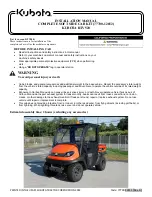
19
EnGLIsh
Attaching the Extension Arms and Work
Supports (Fig. A, P, Q)
IMPORTanT
: Be sure the longer side of the “T” in the work
support arm
9
is oriented down as shown in Figure P. Ensure
the arrow on the label points down.
1. Insert the long work support arm with the small black
cap (
24
, Fig. P) into the hole
25
of the stand closest to the
red activating lever. Push the arm in to snap in place.
2. Repeat for other work support arm on opposite end. Push
the arm in to snap in place. Tighten the horizontal locking
knobs to secure.
3. With the stand raised to desired height, insert the
work support
10
into the top of the extension arm
9
hole. The threaded hole in the work support should be
facing outward.
4. Insert the vertical locking knob
6
into the side hole of the
work support arm. Tighten the vertical lock knob
6
.
5. Repeat with the other work support.
nOTE:
The internal locking mechanism keeps the work support
arm from disengaging.
Attaching the Stop Plate
1. Align the slot in the stoping plate
11
with the outward
facing threaded hole of the work support
10
.
nOTE:
The stopping plate can be attached to either
work support.
2. Secure the stop plate to work support by installing and
tightening knob shown in Figure Q.
Attaching the Tool (Fig. A, H–M)
WARNING:
STABILITY HAZARD.
Refer to your tool
manufacturer’s instructions regarding the securing of
your mitre saw to a stand or supporting surface. Secure
the tool according to both the instructions in this manual
and those in your tool manufacturer’s manual before
operating. Failure to heed these warnings may result in
serious personal injury and serious damage to the tool.
1. Turn the stand right side up and leave stand in closed
position before attaching the saw.
2. Loosen the 6 rail screws
27
with the supplied hex wrench.
Remove the four mounting bolts/flat washers
28
from the
mounting rails
1
.
3. Slide the mounting rails
1
to fit the width of the tool.
4. Place mitre saw on the mounting rails
1
. Centre the
tool, both forward and backward and side to side, on the
stand (Fig. K).
5. Ensure the mounting holes
29
in the tool’s feet align with
the rail (Fig. J).
6. Insert the mounting bolts/flat washers
28
(removed
in STEP 2) through each of the tool’s feet into the captured
nut
32
. Tighten securely.
7. Once the saw is tight to the rails, tighten the rail screws
27
loosened in STEP 2.
If Your Saw Does Not Readily Fit the
Mounting Rails
IMPORTanT:
The mitre saw MUST be positioned so the tool is
bolted squarely to the mounting rails.
WARNING: STABILITY HAZARD.
If the tool’s mounting
holes do not line up with the slots in the mounting rails,
mount the mitre saw to a piece of 19 mm plywood (See
Figure L for dimensions). The plywood must be a minimum
of 102 mm wider than the tool base being mounted and a
minimum depth of 435 mm. Plywood must be at least as
deep as the tool base being mounted. Drill 9.5 mm holes
near both ends of the plywood to align with the slots in
the mounting rails as described in
attaching the Tool
.
Other hardware (not supplied) may be necessary under
these circumstances.
WARNING:
STABILITY HAZARD
. All purchased hardware
must be a minimum of Grade 2. Hardware should be
31.8 mm longer than the thickness of the tool base you
are assembling.
NOTICE:
To prevent binding and/or inaccuracy, ensure
the plywood is not warped or uneven. If binding and/
or inaccuracy occurs, replace the plywood with a non-
warped, even piece of plywood.
Product Stability Test (Fig. I, R, S)
IMPORTanT:
This test must be performed prior to using stand
and saw together.
The rolling mitre saw stand is designed to be used in
conjunction with a wide variety of mitre saws, compound mitre
saws and sliding compound mitre saws.
WARNING:
For your own safety, use two or more
people to perform the stability test or serious injury
could result.
WARNING:
The cutting head MUST be raised on
all mitre saws, compound mitre saws and sliding
compound mitre saws. All sliding compound mitre
saws MUST be locked in the rear position. Failure to
do so may result in serious personal injury.
WARNING: STABILITY HAZARD. Stay alert. The
stand may tip during this procedure. Serious injury
may result.
1. With one person in front of saw/stand and one person in
back of saw/stand, both ready to catch saw, the person
in front lifts the front legs approximately 65 mm and
then lets it go, dropping it. Does stand tend to tip over
toward front? If so, re-adjust saw further back on stand and
retighten fasteners.
2. The person in back lifts rear legs approximately 65 mm and
drops it. Does stand tend to tip over toward back?
If so, readjust saw toward front of stand and
retighten fasteners
27
.
















































